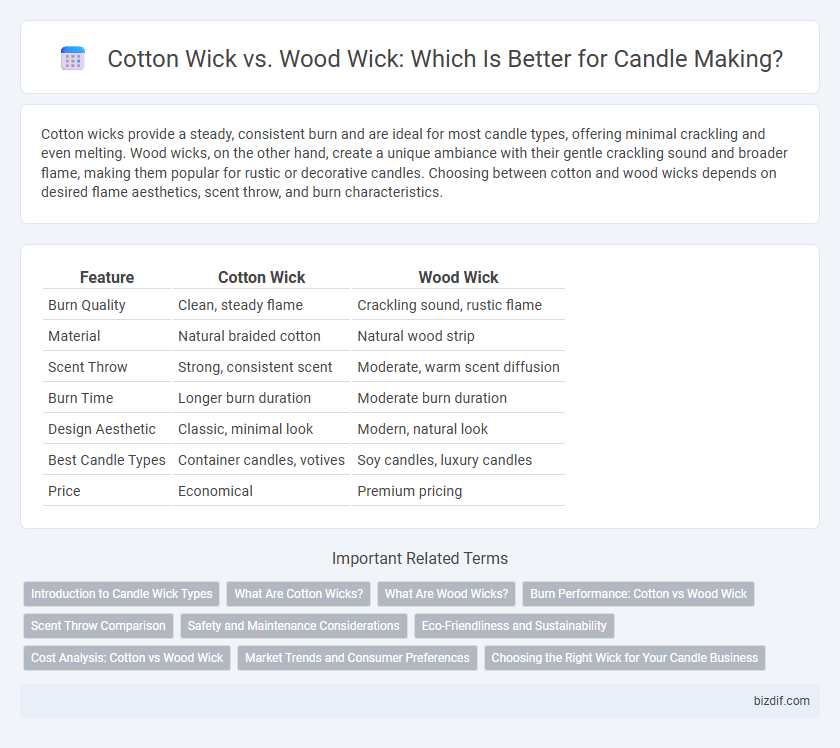Cotton wicks provide a steady, consistent burn and are ideal for most candle types, offering minimal crackling and even melting. Wood wicks, on the other hand, create a unique ambiance with their gentle crackling sound and broader flame, making them popular for rustic or decorative candles. Choosing between cotton and wood wicks depends on desired flame aesthetics, scent throw, and burn characteristics.
Table of Comparison
| Feature | Cotton Wick | Wood Wick |
|---|---|---|
| Burn Quality | Clean, steady flame | Crackling sound, rustic flame |
| Material | Natural braided cotton | Natural wood strip |
| Scent Throw | Strong, consistent scent | Moderate, warm scent diffusion |
| Burn Time | Longer burn duration | Moderate burn duration |
| Design Aesthetic | Classic, minimal look | Modern, natural look |
| Best Candle Types | Container candles, votives | Soy candles, luxury candles |
| Price | Economical | Premium pricing |
Introduction to Candle Wick Types
Candle wick types primarily include cotton wicks and wood wicks, each offering distinct burning characteristics. Cotton wicks provide a steady, traditional flame and are widely used for various candle shapes and scents due to their flexibility and consistent burn. Wood wicks create a unique crackling sound and a broader flame, enhancing ambiance while requiring specific wax blends to ensure optimal burning performance.
What Are Cotton Wicks?
Cotton wicks are traditional candle wicks made from braided or twisted cotton fibers, designed to provide a steady and even flame. They absorb melted wax effectively, ensuring consistent fuel supply for a clean burn without excessive soot. Cotton wicks are widely preferred for soy, paraffin, and beeswax candles due to their reliable performance and ease of trimming.
What Are Wood Wicks?
Wood wicks are thin, flat pieces of untreated wood used as candle wicks, offering a distinctive crackling sound and a unique burning experience compared to traditional cotton wicks. They create a wider flame and produce a cozy ambiance by mimicking the sound of a small fireplace, enhancing the sensory appeal of candles. Preferred in natural or eco-friendly candle making, wood wicks help achieve a slower, more even burn with less soot.
Burn Performance: Cotton vs Wood Wick
Cotton wicks provide a steady, consistent flame producing minimal soot and a clean burn ideal for small to medium candles. Wood wicks create a unique crackling sound and a larger flame, offering a rustic ambiance but may produce more soot and require careful trimming to avoid uneven burning. Choosing between cotton and wood wicks depends on the desired burn time, flame size, and overall sensory experience in candle making.
Scent Throw Comparison
Cotton wicks typically provide a stronger scent throw in candle making due to their consistent and even burning, which helps disperse fragrance oils more effectively throughout a room. Wood wicks produce a softer, crackling burn that creates ambiance but often results in a subtler scent throw compared to cotton wicks. The choice between cotton and wood wicks significantly impacts fragrance diffusion intensity, influencing the overall sensory experience of handmade candles.
Safety and Maintenance Considerations
Cotton wicks are generally safer due to their lower burn temperature and minimal risk of sparking, requiring regular trimming to prevent soot buildup and maintain even burning. Wood wicks offer a unique crackling effect but demand careful monitoring as they can produce larger flames and occasional popping, increasing fire hazard if not properly maintained. Both wick types benefit from keeping candles away from drafts and ensuring proper extinguishing to enhance safety during use.
Eco-Friendliness and Sustainability
Cotton wicks are typically biodegradable and sourced from renewable plants, making them a sustainable choice for eco-conscious candle makers. Wood wicks, often harvested from sustainably managed forests, provide a cleaner burn with less soot, contributing to better indoor air quality. Both wick types support eco-friendly candle production, but wood wicks offer enhanced sustainability through their renewable wood origins and reduced environmental impact during burning.
Cost Analysis: Cotton vs Wood Wick
Cotton wicks generally cost less than wood wicks, making them a more budget-friendly option for candle makers. Wood wicks, while pricier, provide a unique crackling sound and a stronger flame, which can enhance the candle's aesthetic and sensory appeal, potentially justifying the higher expense. Bulk purchasing of cotton wicks often results in significant savings, whereas wood wicks may require careful selection and sizing to match candle dimensions, influencing overall cost efficiency.
Market Trends and Consumer Preferences
Cotton wicks dominate the candle market due to their affordability, consistent burn, and versatility across scented and unscented candles, driving strong consumer preference. Wood wicks, gaining traction for their eco-friendly appeal and unique crackling sound, appeal to niche markets seeking premium, sensory-rich experiences. Market trends indicate a growing demand for sustainable and artisanal candles, boosting wood wick adoption despite higher production costs.
Choosing the Right Wick for Your Candle Business
Selecting the ideal wick is crucial for optimizing burn quality and customer satisfaction in your candle business. Cotton wicks offer consistent, clean combustion suited for a wide range of waxes and scents, while wood wicks provide a distinctive crackling sound and a unique aesthetic appeal that can enhance brand differentiation. Evaluating factors like candle size, fragrance load, and target market preferences ensures the right wick choice to boost performance and sales.
Cotton wick vs Wood wick Infographic

 bizdif.com
bizdif.com